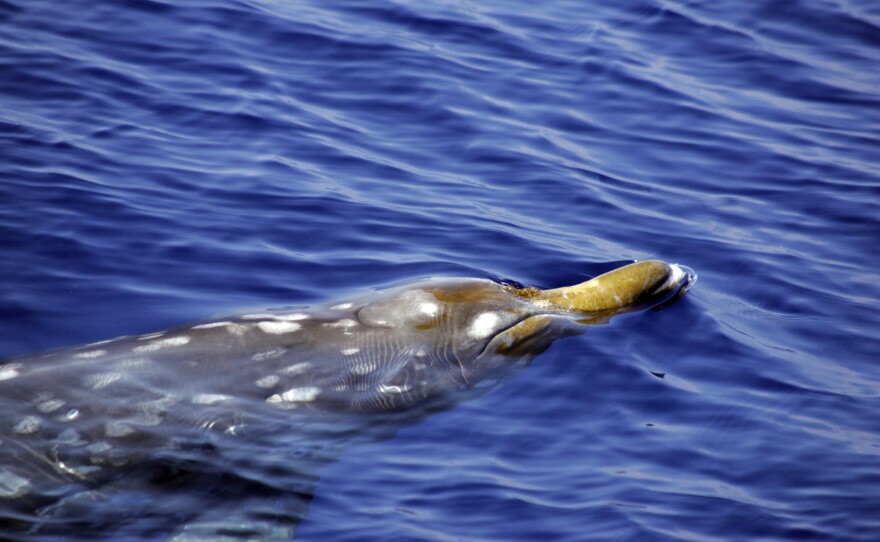Active sonar is the Navy’s best weapon to detect the presence of hostile submarines. But that same powerful underwater pulse of sound can harm or even kill whales and other marine mammals.
Now, the Navy is seeking permission to continue using a huge swath of the Northwest coast, from northern California to the Canadian border, for a wide range of naval training and practice, including sonar. The Navy says it’s taking precautions to protect whales, but others say it’s not enough.
A Deafening Sound And Dead Whales
On May 5, 2003, Ken Balcomb noticed something very strange in Haro Strait, a body of water along the U.S.-Canada border in Washington state.
“All the porpoises and the minke whales, and the killer whales were fleeing the area,” Balcomb said.
Balcomb, senior scientist and director at the Center for Whale Research on San Juan Island, says the animals looked like they were frantically trying to escape something. Some of the local killer whales, he said, “came right up along the shoreline, directly in front of my house. And then it looked as though they were going to strand on the beach at my house.”
At the same time, a deafening sound was picked up by underwater microphones used by researchers to record killer whale vocalizations.
A Navy destroyer, the U.S.S. Shoup, was using active sonar as part of an exercise in Haro Strait, generating pulses of 140 decibels or more — as loud as standing near a fighter jet during takeoff.
In the following days, at least 10 harbor porpoises were found dead in the area, some with blood coming from their heads. Some frozen bodies were sent for analysis, but researchers couldn’t conclusively determine whether the sonar had contributed to the deaths.
For Balcomb, it felt like déjà vu. Three years earlier, he’d studied a mass stranding of dolphins following a Navy sonar exercise in the Bahamas. Balcomb says he suspected the intense pressure of the sonar pulses played a role.
“So I collected and froze heads, and took them to Harvard Medical School. And we CAT scanned them and showed they had hemorrhagic damage in the brain and ears,” he said.
Navy: ‘Continual [Sonar] Training Is Absolutely Necessary’
These incidents and other like them led to limitations on how and where the Navy can conduct sonar exercises. Now, as the Navy seeks to renew permits to train and test in the Northwest, it’s trying to minimize the harm to marine mammals.
John Mosher is in charge of the Navy’s environmental review of the project. He says the plan is to have trained lookouts keep an eye out for whales.
“Their job is to look for marine life, and if any is detected, to notify those people on the ship who are operating
those systems and operating the ship,” Mosher said.
If animals are spotted, sonar testing could be delayed until they leave the area. Mosher says the Navy is very concerned about its impact on wildlife.
“We’re certainly not out there, just blindly doing the training without any regard for the environment. There are hundreds of people doing what I do, and that’s ensuring we’re doing everything we can to protect the environment while we do that very important mission,” Mosher said.
Mosher says that mission of protecting the nation requires that sailors train and practice frequently.
“These are skills that are not easy, they are perishable and can be lost over time, so continual training is an absolute necessity,” he said.
‘No Steps To Keep Navy Out’ Of Marine Mammals’ Way
But Zak Smith, an attorney for the Natural Resources Defense Council, an environmental group, says the government could do a lot more to reduce the threat to whales. He says the National Marine Fisheries Service, which is responsible for marine mammal protection, has let the Navy off easy.
“Here they have consistently taken no steps to keep the Navy out of areas that are high in density for marine mammals,” Smith said.
The Natural Resources Defense Council has been in court for several years, trying to force the government to put stricter limits on the Navy’s use of sonar in coastal waters where whales are present. Smith points to documents in which the Navy concedes that, despite its efforts to avoid harm, it expects to impact marine mammals hundreds of thousands of times over the five-year permit period. He says that shows the effect of the Navy’s safety measures is limited.
“And that limitation is, it only really works to limit the most serious harm,” Smith said.
Smith says the number of whales and other marine mammals outright killed or permanently deafened may be decreased by the lookouts and other Navy precautions, but other impacts that damage the animals’ ability to feed or reproduce won’t.
“Temporary hearing loss will continue, behavioral disruption will continue, and their lookout regime doesn’t do anything to limit that,” he said.
Smith says the Navy should be restricted from using sonar during times of the year when seasonal migrations bring concentrations of whales into coastal waters. Ken Balcomb, from the Center for Whale Research agrees. For example, he says, the Northwest’s endangered orca whales typically spend May through October in the inside waters near Puget Sound and Georgia Strait.
“Likewise the migrations of gray whales, blue whales, fin whales. We know the productivity areas that they visit. These should be taken into account,” said Balcomb.
In order to maintain combat readiness, the Navy says, its personnel must be able to train in all areas, in all seasons. The Navy is holding a series of public meetings on the environmental impact statement for the Northwest Training and Testing Area. Meetings will be held in communities from Oak Harbor, Washington to Fort Bragg California. The deadline for comment is March 25.








